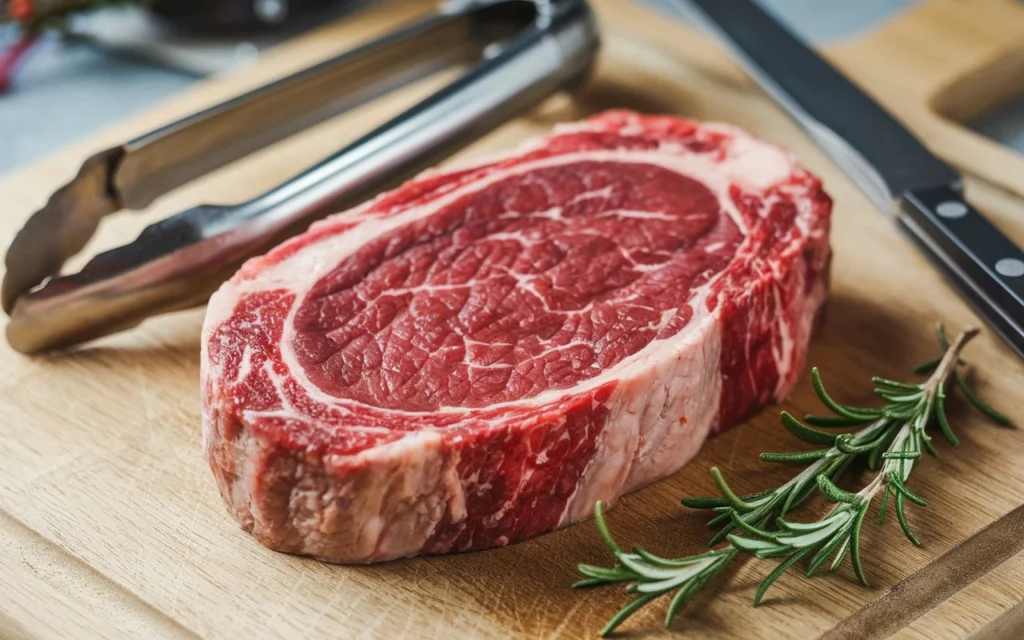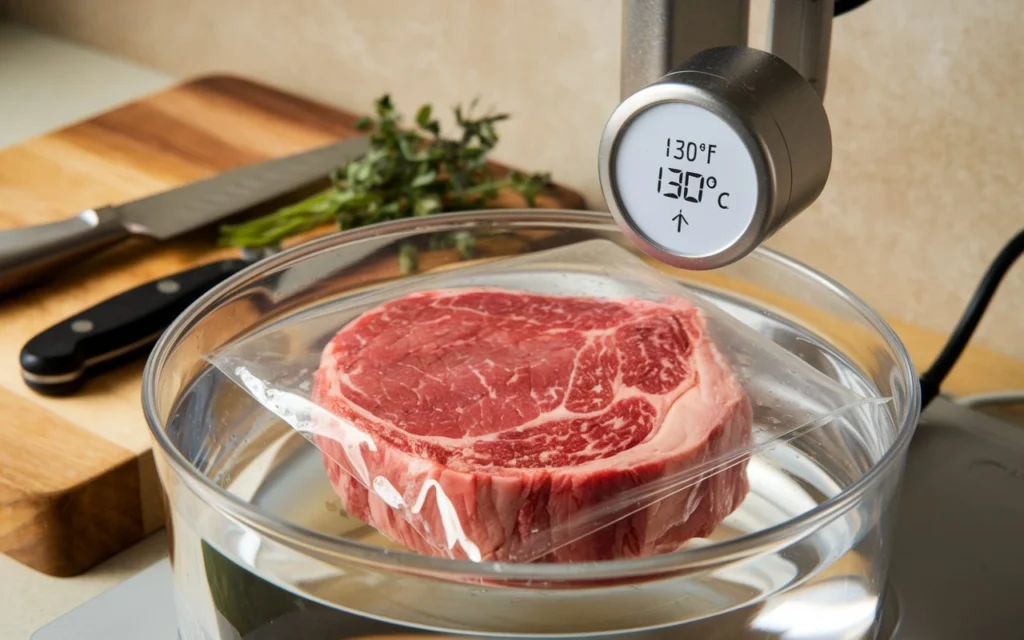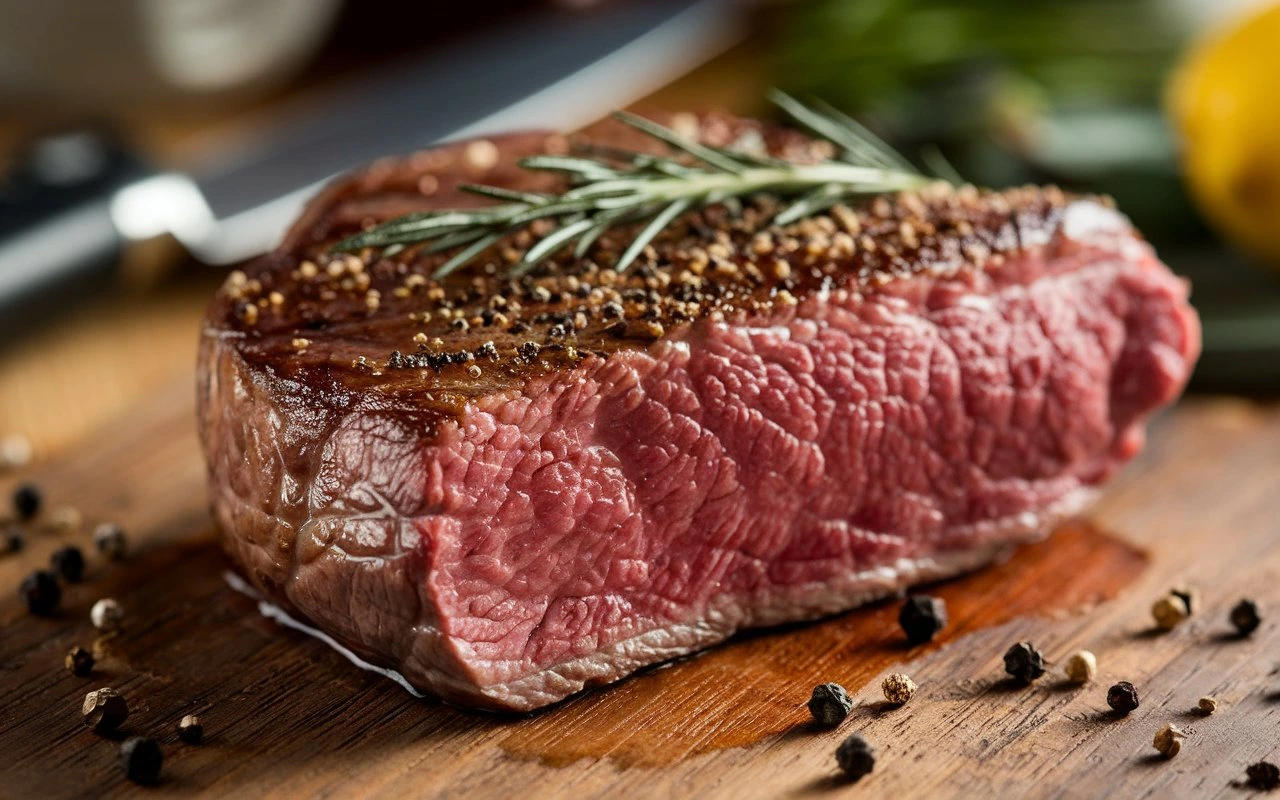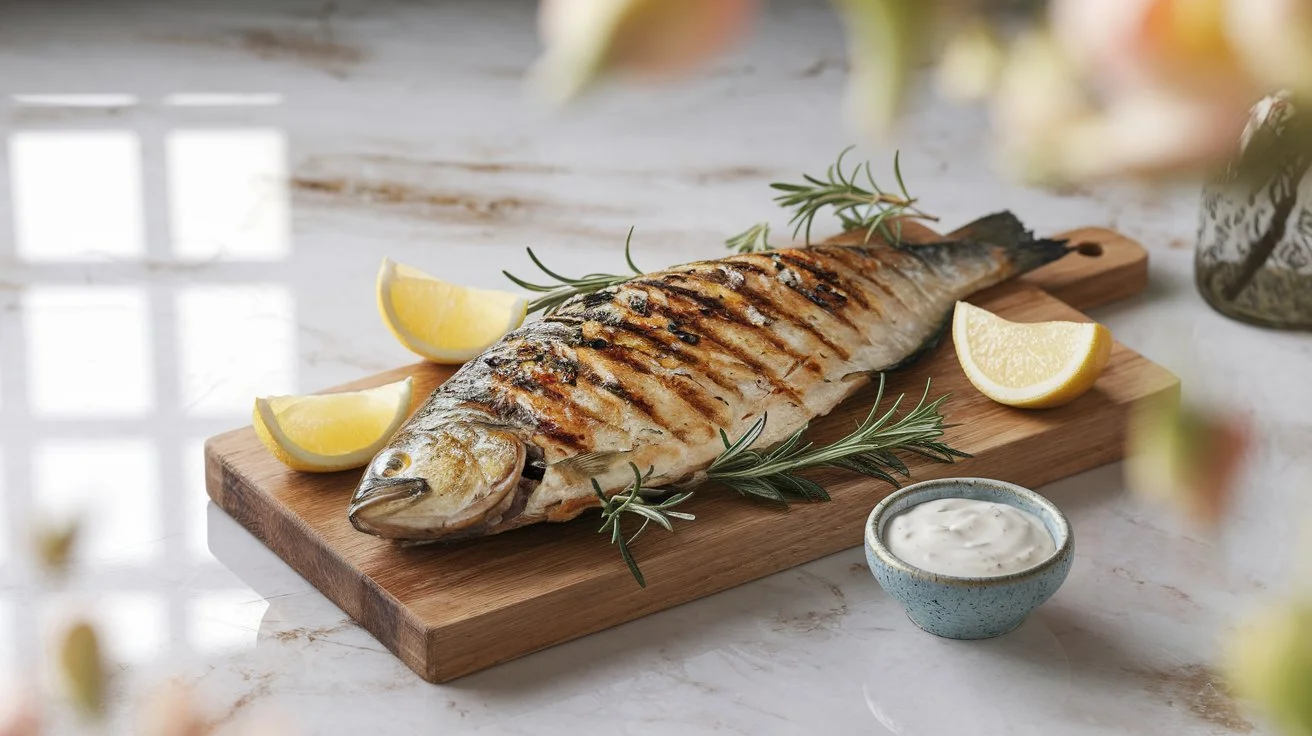Introduction
Imagine taking a frozen steak straight from the freezer and transforming it into a juicy, tender, restaurant-quality masterpiece. Sounds too good to be true, right? Well, with the sous vide frozen steak method, it’s not only possible—it’s practically foolproof! Cooking steak from frozen has long been seen as a culinary challenge, but sous vide changes everything.
Sous vide, which means “under vacuum” in French, involves slow-cooking food in a water bath at a precise temperature. This technique guarantees consistent doneness, edge to edge, without the risk of overcooking. Even better, you don’t need to defrost the steak beforehand, saving time and effort.
This guide will walk you through everything you need to know about preparing, cooking, and finishing sous vide frozen steak to perfection. From selecting the best cuts to nailing the perfect sear, every step is covered. Let’s dive in!

Introduction to Sous Vide Frozen Steak
What Is Sous Vide Frozen Steak?
If you’ve ever wondered, “Can I cook steak straight from the freezer?” the answer is a resounding YES! Sous vide frozen steak refers to cooking a frozen steak using the sous vide method—without thawing it first. This is a major time-saver for busy weeknights when you forget to defrost dinner.
Unlike traditional methods, where frozen steak often cooks unevenly, sous vide ensures every inch of the steak cooks at the exact same temperature. The result? A steak that’s just as tender and flavorful as one cooked from fresh.
Why Cook Steak Using the Sous Vide Method?
Sous vide cooking isn’t just a trendy kitchen hack—it’s a culinary game-changer. Here’s why:
- Consistent Doneness: With sous vide, every bite is cooked to the same level of doneness, from edge to center. No overcooked outsides and raw insides!
- Time-Saving: Skip the defrosting process entirely. Pop it in the water bath while it’s frozen.
- Enhanced Flavor: Since the steak cooks in a sealed bag, it retains all its natural juices, flavor, and aroma.
- No Guesswork: Set the temperature, and let the sous vide do the work. You can’t “accidentally” overcook it.
If precision cooking sounds like something you’d want to master, then sous vide frozen steak is the perfect way to start.
Understanding Sous Vide Cooking
Sous vide cooking works by immersing food in a water bath that maintains a stable temperature. This process is guided by an immersion circulator, a handy device that heats and circulates the water, ensuring the temperature stays constant.
Here’s why this matters:
- Precision Cooking: Unlike grilling or pan-frying, where high heat can overcook your food quickly, sous vide holds the water at a set temperature, so your steak can’t overcook.
- Perfect Texture: Sous vide breaks down proteins at a controlled pace, creating that melt-in-your-mouth texture.
- Hands-Off Cooking: While the steak is cooking, you can focus on other tasks. No need to babysit it like you would with grilling or pan-frying.
In simple terms, sous vide lets you “set it and forget it” until it’s time for a final sear.
Benefits of Cooking Steak from Frozen
Why freeze your steak in the first place? And more importantly, why cook it straight from frozen? Here’s why sous vide frozen steak is so popular:
- Skip the Thawing Hassle: Defrosting steak can take hours, and quick-thawing methods like microwaving can ruin the texture. Sous vide skips that entire process.
- Juicier Steak: Cooking steak directly from frozen locks in the juices. Since it stays in the sealed bag for the entire process, the steak doesn’t dry out.
- Save Time and Effort: No need to plan meals ahead of time or remember to defrost meat. Just grab a frozen steak and toss it in the water bath.
- Avoid Food Safety Issues: Defrosting steak at room temperature can lead to bacteria growth, but sous vide eliminates this risk since it cooks the steak at a safe temperature.
Preparing Frozen Steak for Sous Vide
If you want a sous vide frozen steak that’s tender, juicy, and bursting with flavor, preparation is key. While sous vide cooking may seem like a “set it and forget it” method, the steps before cooking can make a world of difference. This part will guide you on how to choose the right steak cut, season it to perfection, and package it for ideal sous vide results.

Selecting the Right Cut of Steak
Not all steaks are created equal, and some cuts perform better than others when cooked from frozen. Here’s what you need to know when selecting your steak for sous vide frozen steak.
Best Cuts for Sous Vide Frozen Steak
Certain cuts of steak naturally yield better results in a sous vide water bath. These include:
- Ribeye: With its marbling and rich fat content, ribeye turns out tender and juicy every time.
- Filet Mignon: Known for its buttery texture, this lean cut maintains its tenderness when cooked sous vide, even from frozen.
- Sirloin: This versatile cut offers a balance of tenderness and flavor, making it ideal for sous vide cooking.
- Strip Steak (New York Strip): Packed with flavor and a firmer texture, it cooks wonderfully from frozen without becoming chewy.
These cuts are known for their ability to maintain flavor and tenderness even when frozen. Leaner cuts like flank steak or eye of round can still work, but they may require longer cooking times to break down tougher fibers.
Avoid These Mistakes When Choosing Steak Cuts
- Avoid Overly Lean Cuts: While lean cuts like top round or bottom round can be cooked sous vide, they might require additional time to tenderize.
- Watch for Thickness: Thinner steaks (under 1 inch) can cook too quickly, which may affect texture. Look for cuts at least 1.25 to 2 inches thick for ideal results.
- Poor Marbling = Poor Flavor: Steaks with less marbling won’t have the same rich, buttery flavor. Choose cuts with visible fat marbling for the best taste and tenderness.
The best steak for sous vide frozen steak is one that’s thick, well-marbled, and able to withstand slow, gentle cooking without becoming tough. If you have a choice, go with a ribeye or a filet mignon for melt-in-your-mouth goodness.
Seasoning and Packaging the Steak
Once you’ve picked your perfect cut, it’s time to season and package it for cooking. While sous vide ensures the steak cooks evenly, seasoning and sealing play a crucial role in flavor development.
When and How to Season Frozen Steak
One of the most common questions is: Should I season the steak before or after sous vide? The answer depends on personal preference, but here are some guidelines to follow.
- Season Before Cooking: Most chefs recommend seasoning before sous vide cooking. This allows the steak to absorb the flavors during the slow cook.
- Best Seasonings to Use: Keep it simple with classic seasonings like:
- Salt and Pepper: Enhances the natural flavors of the beef.
- Garlic Powder: Adds an aromatic punch to the flavor.
- Fresh Herbs (Rosemary, Thyme, Oregano): Infuses subtle herb flavors.
- Garlic Cloves or Crushed Garlic: For that deep, rich garlic essence.
- Don’t Overdo It: Since sous vide locks in moisture, the flavor of seasonings can be more intense. Use seasonings sparingly to avoid overpowering the natural taste of the steak.
Some chefs prefer to add fresh herbs, garlic, or butter after the sous vide cook. This way, the herbs stay fresh, and the butter enhances the searing process.
Packaging Tips for Sous Vide Frozen Steak
Proper packaging ensures the steak cooks evenly and doesn’t lose any of its delicious juices. Here’s how to package it like a pro.
1. Vacuum Sealing Method
- Why It’s Preferred: Vacuum-sealing removes all air from the bag, ensuring a tight seal around the steak. This guarantees even cooking and prevents the steak from floating in the water bath.
- How to Do It:
- Place the seasoned steak in a food-grade vacuum bag.
- Add optional aromatics (garlic, herbs, butter) for added flavor.
- Seal the bag using a vacuum sealer to remove all the air.
2. Ziplock Bag Water Displacement Method
- Why It’s a Good Backup: If you don’t have a vacuum sealer, a ziplock bag works just as well.
- How to Do It:
- Place the seasoned steak in a freezer-safe ziplock bag.
- Lower the bag slowly into a container of water, letting the water pressure push the air out of the bag.
- Once the bag is mostly submerged and air is removed, seal it tightly.
Pro Tips for Packaging
- Avoid Air Pockets: Air trapped inside the bag can cause the steak to float, leading to uneven cooking.
- Double-Bag for Extra Protection: If you’re worried about leaks, use a second bag to keep the water out.
- Label and Date the Bag: If you’re freezing steak ahead of time, label it so you know what cut it is and when it was frozen.
Sous Vide Cooking Process for Frozen Steak
Now that your steak is prepped and perfectly sealed, it’s time to cook it to mouthwatering perfection. The beauty of sous vide frozen steak is that you don’t need to defrost it, but it does require a bit more time than cooking a fresh steak. In this part, we’ll walk you through how to set the right temperature and time for flawless doneness, plus tips to avoid common cooking mistakes.
Setting the Temperature and Time
The key to a perfectly cooked sous vide frozen steak lies in precision. Unlike pan-frying or grilling, sous vide allows you to control the exact temperature, ensuring consistent doneness from edge to edge.
Temperature and Time Guide for Different Doneness Levels
Here’s a quick reference for common doneness levels:
- Rare: 120°F (49°C) for 1.5 to 2 hours (add 30 minutes if cooking from frozen)
- Medium-Rare: 129°F (54°C) for 1.5 to 2 hours (add 30 minutes for frozen steak)
- Medium: 135°F (57°C) for 1.5 to 2 hours (add 30 minutes for frozen steak)
- Medium-Well: 145°F (63°C) for 1.5 to 2 hours (add 30 minutes for frozen steak)
- Well-Done: 155°F (68°C) for 1.5 to 2 hours (add 30 minutes for frozen steak)
These times are for 1 to 1.5-inch thick steaks. Thicker cuts (2 inches or more) may need an additional 30-60 minutes. Since frozen steak requires extra time to fully thaw inside the water bath, the general rule is to add 30 extra minutes to the cooking time.
Why Precision Matters
Unlike traditional cooking methods where heat is unpredictable, sous vide keeps water at a consistent, steady temperature. This is important because:
- No Risk of Overcooking: The steak stays at your desired doneness, no matter how long it stays in the water.
- Edge-to-Edge Consistency: Say goodbye to gray, overcooked edges and raw centers. Sous vide gives you a perfectly cooked center from top to bottom.
- Flavor Retention: With precise cooking, natural juices stay inside the steak, delivering rich, meaty flavor in every bite.
When cooking sous vide frozen steak, you’re not racing against the clock. If you’re delayed for 30 minutes, the steak won’t overcook—thanks to the precision of sous vide technology.
Cooking Techniques and Tips
Getting started with sous vide frozen steak is easy, but having a few tricks up your sleeve will make the process smoother. Here’s how to get it right every time.
Step-by-Step Instructions for Cooking Frozen Steak Sous Vide
- Prepare the Water Bath:
- Fill a large pot or sous vide container with water.
- Attach your sous vide immersion circulator to the side of the pot.
- Set the Temperature:
- Choose your desired doneness (see temperature chart above) and set the sous vide device to that temperature.
- Allow the water to preheat, which usually takes about 10-15 minutes.
- Submerge the Sealed Steak:
- Place your vacuum-sealed or ziplock-sealed frozen steak in the water.
- Make sure it’s fully submerged and not floating. If it floats, use a weight or clip to hold it down.
- Cook for the Required Time:
- Start the timer based on the temperature and time guide provided earlier.
- Remember to add 30 extra minutes if you’re cooking from frozen.
- Remove and Prepare for Searing:
- Once cooking is complete, remove the steak from the bag and pat it dry with paper towels.
- Drying the surface ensures the steak will sear better, creating a beautiful golden-brown crust.
How to Check the Steak’s Internal Temperature
While the sous vide method ensures precise cooking, you might want to check the steak’s internal temperature before searing. Here’s how to do it:
- Use an Instant-Read Thermometer: Insert it into the thickest part of the steak.
- For medium-rare, you should see an internal temp of around 129°F (54°C).
- If the internal temp is lower than expected, pop it back in the water for an additional 10-15 minutes.
Since sous vide frozen steak cooks at a controlled temperature, checking the internal temp is more about peace of mind than necessity.
Finishing Techniques After Sous Vide
The magic of sous vide frozen steak doesn’t stop at the water bath. To achieve a truly steakhouse-quality experience, you need to finish it with a proper sear. This step creates that golden-brown, crispy crust that locks in flavor and elevates the entire dish. In this part, you’ll learn the best searing methods, serving suggestions, and even tips for storing and reheating leftovers.
Searing the Sous Vide Steak
Cooking a steak sous vide gives you perfection on the inside, but the outside needs a bit of extra love. Searing adds a beautiful crust that brings flavor, texture, and irresistible aroma.
Why Searing Is Essential After Sous Vide Cooking
After sous vide, the steak is technically cooked, but it looks pale, soft, and unappetizing. Searing serves two critical purposes:
- Flavor Boost: The Maillard reaction occurs during searing, creating a rich, golden-brown crust that’s packed with deep, savory flavors.
- Textural Contrast: While the inside is tender and juicy, the outer crust provides a satisfying crispy bite.
Skipping the sear would be like baking a cake but forgetting to decorate it—unfinished and underwhelming!
Best Methods for Searing Sous Vide Frozen Steak
There’s more than one way to achieve that perfect sear. Here are the top three methods, each with its own pros and cons:
- Pan-Searing (Best Choice)
- How It Works: Heat a cast-iron skillet or stainless steel pan to a screaming hot temperature, add a bit of oil, and sear the steak for 30-60 seconds per side.
- Why It’s Best: A cast-iron skillet retains heat better than most pans, creating a more even crust.
- Pro Tip: Add butter, garlic, and fresh rosemary to the pan during the last 30 seconds for an aromatic finish.
- Grilling
- How It Works: Heat the grill to high and place the steak directly on the grates for 30-60 seconds per side.
- Why It Works: Grilling gives the steak those iconic sear marks, and the smoky flavor adds a tasty twist.
- Pro Tip: Brush the steak with a little oil before grilling to prevent it from sticking to the grates.
- Using a Kitchen Torch
- How It Works: Using a kitchen blowtorch, pass the flame over the surface of the steak until browned.
- Why It Works: Perfect for precision searing where you only want to sear certain areas.
- Pro Tip: Hold the torch 2-3 inches away from the surface and keep it moving to avoid burning one spot.
Tips for Achieving the Perfect Golden-Brown Crust
- Dry It First: Moisture is the enemy of a good sear. Pat the steak completely dry with paper towels before searing.
- Use High Heat: The hotter, the better. The pan should be smoking hot before the steak touches it.
- Don’t Overcrowd the Pan: Cook one steak at a time to avoid lowering the pan’s temperature.
- Oil with a High Smoke Point: Use oils like avocado, vegetable, or grapeseed oil. Avoid butter until the end to prevent it from burning.
With a golden crust that’s crispy, savory, and mouthwateringly delicious, you’ll have a steak worthy of a 5-star steakhouse.
Serving Suggestions for Sous Vide Frozen Steak
Your steak is cooked, seared, and looking irresistible. Now, it’s time to serve it like a pro. Presentation is everything, especially if you want to wow family or guests.
How to Serve Sous Vide Frozen Steak
- Whole: Keep the steak whole for that “restaurant-style” look. Place it on a large wooden board or a plate garnished with rosemary and garlic cloves.
- Sliced: Slice the steak into thin, even pieces to showcase the perfectly pink interior. This method works great for larger cuts like ribeye or sirloin.
- Cubed: Cut the steak into bite-sized cubes to create steak bites for party platters or family-style meals.
Presentation matters, and slicing the steak against the grain can make it look even more tender and juicy.
FAQs for Sous Vide Frozen Steak
Can you sous vide steak directly from frozen?
Yes, you can sous vide steak directly from frozen. The sous vide process handles frozen food efficiently by cooking it slowly and evenly, so there’s no need to thaw it first. Simply add 30 extra minutes to the cooking time.
What temperature should I use for sous vide frozen steak?
The optimal temperature depends on your desired doneness:
Rare: 120°F (49°C)
Medium-Rare: 129°F (54°C)
Medium: 135°F (57°C)
How long does it take to sous vide a frozen steak?
Cooking time depends on steak thickness, but for 1-1.5 inch thick steaks, cook for 1.5 to 2 hours plus 30 extra minutes if frozen. Thicker cuts require more time.
Do I need to season a frozen steak before sous vide?
Yes, seasoning before sous vide infuses flavor during cooking. Season with salt, pepper, and herbs before sealing it in a vacuum bag.
Should I defrost steak before sous vide?
No need to defrost! Sous vide cooks steak straight from frozen with no risk of uneven cooking. Just add 30 extra minutes to the cooking time.
What are the best cuts of steak to cook from frozen sous vide?
The best cuts include ribeye, filet mignon, sirloin, and strip steak. These cuts retain tenderness and flavor better than leaner cuts.
Conclusion
The sous vide frozen steak method is a total game-changer. It saves time, delivers unbeatable flavor, and guarantees consistent doneness from edge to edge. No more worrying about defrosting or uneven cooking. By mastering sous vide cooking, searing techniques, and serving suggestions, you’ll have the tools to create a restaurant-quality meal right at home.
Whether you’re making ribeye, filet mignon, or sirloin, the sous vide frozen steak technique ensures tender, juicy results every time. Ready to taste the difference? Give it a try today and experience steak like never before!








